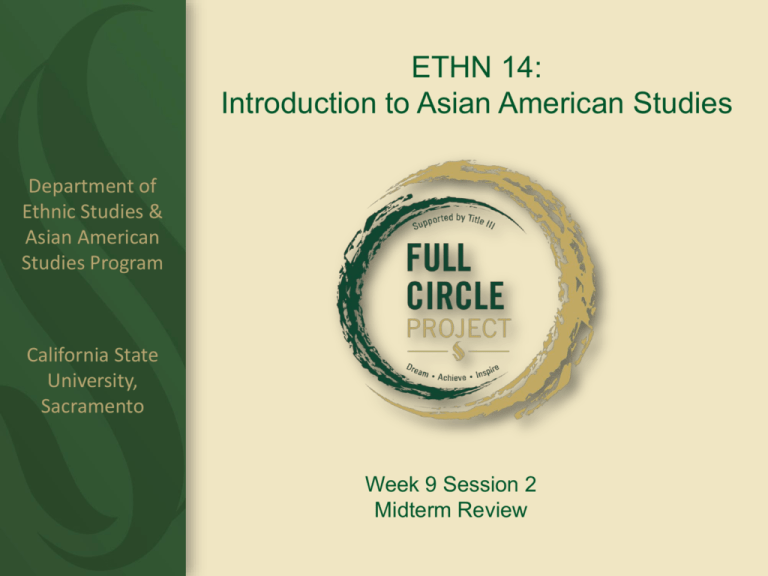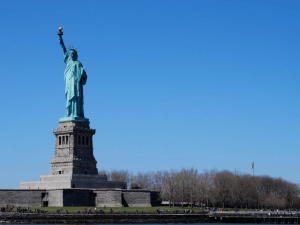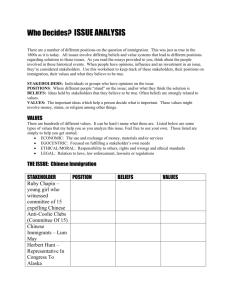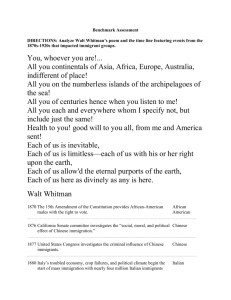Midterm Review
advertisement

ETHN 14: Introduction to Asian American Studies Department of Ethnic Studies & Asian American Studies Program California State University, Sacramento Week 9 Session 2 Midterm Review Last Time • Impact of the Immigration and Naturalization Act of 1965 on the API community • Discuss the Southeast Asian American experiences in the United States • Introduce midterm essay topics Today • Strategies for preparing for the midterm: – Creating the proper mindset for preparing for and performing in exam situations. – Interpreting the prompts – Developing theses from the evidence – Creating an outline – Making an argument Developing a Positive Exam Mindset • “Respect and expectation go hand-in-hand” • FCP success: – – – – More students are set to graduate than non-participating CSUS students Higher GPAs More students report stronger ties to peers, staff, and faculty Increased use of campus resources • Exams are opportunities for feedback and to improve academic skills. Try not to think of them as judgments of your intelligence or self-worth. Developing a Positive Exam Mindset • Preparation = Confidence – – – – “Feel into the stress” and respond to it. Tend to your health: Eat, sleep, and exercise well. Working with others can help you to cope and recognize progress. Having a plan helps to alleviate feeling overwhelmed and defeated. Mid-Term Format Monday, 11/2 • Three to four analytical essay topics will be developed from our class’s cross-group analysis work. You will write on two of them but will need to be prepared for all four. Wednesday, 11/4 • Four identification terms. Short essay explanation of their significance to the API experience and the class. Suggested Strategy • Interpret the prompt • Explore possible evidence • Synthesize evidence into a thesis • Check to make sure the thesis and evidence respond to all of the prompt • Outline your essay • Make an argument. – Do more than summarize. – Explain how your evidence proves your thesis! Topic 1: Sociopolitical Context of API Immigration Asian American Studies scholars routinely situate the emergence of the umbrella term “API” within a historical context of national expansion, colonization, and marketplace dominance. As a result, a central dimension of the collective Asian and Pacific Islander American experience is strong similarities in the sociopolitical context of arrival to and settlement in the United States among different national origin groups. Develop and defend a thesis that characterizes this shared experience with regard to U.S. national interest, labor market conditions, and immigration policy. – The term API came about when the United States expanded, took over other countries, and grew its economy. – A commonality shared by different API groups is that each is connected to this history of expansion, colonization, and globalization (international market dominance). – Create a defendable statement about what these groups have in common as illustrated through the U.S.’s goals, labor needs, and immigration policy. Evidence Evidence 3 2 4 Thesis Evidence 1 Evidence Statement - What do these forms of evidence have in common? - Does this statement address the prompt? Evidence 5 Crosscutting Themes Chinese Americans Japanese Americans Filipino Americans Pacific Islander Americans Immigrant Populations Sojourner immigrants, Chinese Women Poor from rural areas and Ryokyu Islands First, second, and third waves. Immigration and Naturalization Act of 1965 Samoans, Guamanians/Chamorros, Tongans, Hawaiians Settlement Patterns Pacific Coast: California San Francisco Pacific Coast, Hawaii, California San Francisco Second wave, Hawaii, Alaska, and the Pacific coast (Stockton – Key migratory hub) Hawaii – Mormons, economics, Laie (Country came to them, they didn’t come to the country) Factors that influenced Immigration (Push-Pull) Gold Rush, Fall of Saigon Exclusion of Chinese, Agriculture, Railroads, and domestic work Spanish American War, Alaskeros, Immigration and Naturalization Act of 1965, World War II, Pensionados Westernization, World War II, Department of the Interior, 1950 Organic Act, “Land of Opportunity” Family reunification Labor Agriculture, WWII economy Railroads Domestic Services (Laundries) Agriculture, Railroads, and domestic work Alaskeros, The Great Depression, Carlos Bulosan, Agriculture, Domestic service Faasamoa, Modernization, Unskilled; semi-skilled labor (e.g. custodians, cooks, clerks) Country of Origin’s Relationship with US Government Immigration Act of 1965, The Good Earth, Arrival of Chinese Women, Ping Pong Diplomacy Gentlemen’s Agreement, Meiji Revolution, Attack on Pearl Harbor Pensionados, Imperialism, colonization, PhilippineAmerican War, Tydings McDuffie Act American Samoa/Western Samoa Dole vs. Cleveland Exclusion, Surveillance, and Discrimination Foreign Miner’s Tax Chinese Exclusion Act Ordinances on Living and Labor Conditions, Cold War, Hiram Fong, FOB/ABC, Dr. Wen Ho Lee San Francisco School Board incident, Anti-miscegenation laws, restrictive covenants, Alien Land Act (1913 and 1920), CWIRC/Exec Order 9066 Anti-Miscegenation laws, The Great Depression, Watsonville Riot, fight for Affirmative Action Christian Missionaries Great Mahele Community Institutions Family Associations, Paper Sons Six Companies Native Sons of the Golden State, levels of educaiton Japanese Association of America, Japanese American Citizens League (JACL) Catholicism, Visayan, Tagalog, and Illocano, Lodges—Men’s women’s and youth and churces Matai, Haole society, plantation life, and Hawaiian traditional culture, Hawaiian Homes Commission, Council of Hawaiian Organizations Cultural representations of the racialized “other” Hatchet men, Yellow Peril, Model Minorities, Tianaman Square The second generation Japanese Problem, Yellow Peril, Scientific racism/social darwinism “Little Brown Brothers” Allos in America is in the Heart Meed-Freeman controversy, colonization, imperialism, Comparison between Native Hawaiians and Americans Generations and Acculturation Native Sons of the Golden State, FOBs ABCs Issei, Nisei, Sanseil; redress Pre- and post-1965; “Bridge generation” Refugee processing centers, Generational role reversal, Crosscutting Themes South Asian Americans Korean Americans Southeast Asian Americans Immigrant Populations Sojourner immigrants, Punjabi, Pakistanis, Bangladeshis, Majority men Whole families, War Brides, First, second and third waves Refugees: Vietnamese, Laotians (Hmong and Lao), Cambodians, and ethnic Chinese. First and second generation Settlement Patterns Mainly Western US, but dispersed Northern Sacramento Valley, Imperial Valley, Tech communities Hawaii, California Early Waves: urban; Third wave: suburban LA county; South Central LA; Dispersed settlement Resettlement programs; Minneapolis, Fresno Factors that influenced Immigration (PushPull) 1946 Act Railroads Immigration Act of 1965 Japanese Occupation of Korea Korean War Immigration and Naturalization Act of 1965 Vietnam War; “Push immigrants” vs. “Pull Immigrants”, Dienbienphu Labor Gujuarato, Dalip Singh Saund, Post1965: skilled, technical, management, highly educated Agriculture Family business model Agricuture; unskilled labor Country of Origin’s Relationship with US Government British colonization 9/11 Treaty at Chamulpo Korean War Student refugees Vietnam War, Cold War Exclusion, Surveillance, and Discrimination Thind Case Alien Land Act (1920) Hemet Valley Incident Language Gap Familiarity with institutions Riots of 1992 Few jobs, Goal was to scatter resettlement, nativist resentment of assistance, discrimination based on language status Community Institutions Indian League of America, Gadar Movement Family Christian Church Presbyterianism Family business model Strain on local agencies, Southeast Asian Mutual Assistance programs, Little Saigon Cultural representations of the racialized “other” Terrorists, ”Least Desirable Race” M*A*S*H* Movie, Falling Down Riots of 1992 Child brides, boat people Generations and Acculturation Immigration Act of 1965 Refugee processing centers, Generational role reversal, language difficulties, cultural challenges Topic 2: Cultural Representations, Discrimination, and Maintaining Privilege Numerous stereotypes experienced by API groups reflect a history of orientalism, or an assumption by westerners that easterners are “cultural others.” Some examples include yellow peril, perpetual foreigners, and the model minority. Oftentimes, representations like these justify forms of discrimination. Develop and argue a thesis that explores how cultural representations of Asian and Pacific Islander Americans promote and maintain a system of material wealth and privilege for those of the dominant culture in the United States. Crosscutting Themes Chinese Americans Japanese Americans Filipino Americans Pacific Islander Americans Immigrant Populations Sojourner immigrants, Chinese Women Poor from rural areas and Ryokyu Islands First, second, and third waves. Immigration and Naturalization Act of 1965 Samoans, Guamanians/Chamorros, Tongans, Hawaiians Settlement Patterns Pacific Coast: California San Francisco Pacific Coast, Hawaii, California San Francisco Second wave, Hawaii, Alaska, and the Pacific coast (Stockton – Key migratory hub) Hawaii – Mormons, economics, Laie (Country came to them, they didn’t come to the country) Factors that influenced Immigration (Push-Pull) Gold Rush, Fall of Saigon Exclusion of Chinese, Agriculture, Railroads, and domestic work Spanish American War, Alaskeros, Immigration and Naturalization Act of 1965, World War II, Pensionados Westernization, World War II, Department of the Interior, 1950 Organic Act, “Land of Opportunity” Family reunification Labor Agriculture, WWII economy Railroads Domestic Services (Laundries) Agriculture, Railroads, and domestic work Alaskeros, The Great Depression, Carlos Bulosan, Agriculture, Domestic service Faasamoa, Modernization, Unskilled; semi-skilled labor (e.g. custodians, cooks, clerks) Country of Origin’s Relationship with US Government Immigration Act of 1965, The Good Earth, Arrival of Chinese Women, Ping Pong Diplomacy Gentlemen’s Agreement, Meiji Revolution, Attack on Pearl Harbor Pensionados, Imperialism, colonization, PhilippineAmerican War, Tydings McDuffie Act American Samoa/Western Samoa Dole vs. Cleveland Exclusion, Surveillance, and Discrimination Foreign Miner’s Tax Chinese Exclusion Act Ordinances on Living and Labor Conditions, Cold War, Hiram Fong, FOB/ABC, Dr. Wen Ho Lee San Francisco School Board incident, Anti-miscegenation laws, restrictive covenants, Alien Land Act (1913 and 1920), CWIRC/Exec Order 9066 Anti-Miscegenation laws, The Great Depression, Watsonville Riot, fight for Affirmative Action Christian Missionaries Great Mahele Community Institutions Family Associations, Paper Sons Six Companies Native Sons of the Golden State, levels of educaiton Japanese Association of America, Japanese American Citizens League (JACL) Catholicism, Visayan, Tagalog, and Illocano, Lodges—Men’s women’s and youth and churces Matai, Haole society, plantation life, and Hawaiian traditional culture, Hawaiian Homes Commission, Council of Hawaiian Organizations Cultural representations of the racialized “other” Hatchet men, Yellow Peril, Model Minorities, Tianaman Square The second generation Japanese Problem, Yellow Peril, Scientific racism/social darwinism “Little Brown Brothers” Allos in America is in the Heart Meed-Freeman controversy, colonization, imperialism, Comparison between Native Hawaiians and Americans Generations and Acculturation Native Sons of the Golden State, FOBs ABCs Issei, Nisei, Sanseil; redress Pre- and post-1965; “Bridge generation” Refugee processing centers, Generational role reversal, Crosscutting Themes South Asian Americans Korean Americans Southeast Asian Americans Immigrant Populations Sojourner immigrants, Punjabi, Pakistanis, Bangladeshis, Majority men Whole families, War Brides, First, second and third waves Refugees: Vietnamese, Laotians (Hmong and Lao), Cambodians, and ethnic Chinese. First and second generation Settlement Patterns Mainly Western US, but dispersed Northern Sacramento Valley, Imperial Valley, Tech communities Hawaii, California Early Waves: urban; Third wave: suburban LA county; South Central LA; Dispersed settlement Resettlement programs; Minneapolis, Fresno Factors that influenced Immigration (PushPull) 1946 Act Railroads Immigration Act of 1965 Japanese Occupation of Korea Korean War Immigration and Naturalization Act of 1965 Vietnam War; “Push immigrants” vs. “Pull Immigrants”, Dienbienphu Labor Gujuarato, Dalip Singh Saund, Post1965: skilled, technical, management, highly educated Agriculture Family business model Agricuture; unskilled labor Country of Origin’s Relationship with US Government British colonization 9/11 Treaty at Chamulpo Korean War Student refugees Vietnam War, Cold War Exclusion, Surveillance, and Discrimination Thind Case Alien Land Act (1920) Hemet Valley Incident Language Gap Familiarity with institutions Riots of 1992 Few jobs, Goal was to scatter resettlement, nativist resentment of assistance, discrimination based on language status Community Institutions Indian League of America, Gadar Movement Family Christian Church Presbyterianism Family business model Strain on local agencies, Southeast Asian Mutual Assistance programs, Little Saigon Cultural representations of the racialized “other” Terrorists, ”Least Desirable Race” M*A*S*H* Movie, Falling Down Riots of 1992 Child brides, boat people Generations and Acculturation Immigration Act of 1965 Refugee processing centers, Generational role reversal, language difficulties, cultural challenges Evidence Evidence 3 2 4 Thesis Evidence 1 Evidence Statement - What do these forms of evidence have in common? - Does this statement address the prompt? Evidence 5 Topic 3: Structural Influences on Acculturation Historically, social scientists viewed ethnic group arrival, settlement, and adaptation through the lens of assimilation. The guiding assumption of their analyses was that all groups eventually lose their cultural differences to become part of the dominant group. In more recent decades, scholars moved away from assimilation theory to acculturation theory. Acculturation theory rejects the “all or nothing” and linear view of culture (culture does not “get lost,” it evolves). Instead, ethnic group arrival, settlement, and adaptation are viewed as negotiations, or an ongoing process of “picking and choosing” between cultural rituals, forms, values, and influences. Develop and argue a thesis that explores how structural factors influenced API acculturation in the United States. Crosscutting Themes Chinese Americans Japanese Americans Filipino Americans Pacific Islander Americans Immigrant Populations Sojourner immigrants, Chinese Women Poor from rural areas and Ryokyu Islands First, second, and third waves. Immigration and Naturalization Act of 1965 Samoans, Guamanians/Chamorros, Tongans, Hawaiians Settlement Patterns Pacific Coast: California San Francisco Pacific Coast, Hawaii, California San Francisco Second wave, Hawaii, Alaska, and the Pacific coast (Stockton – Key migratory hub) Hawaii – Mormons, economics, Laie (Country came to them, they didn’t come to the country) Factors that influenced Immigration (Push-Pull) Gold Rush, Fall of Saigon Exclusion of Chinese, Agriculture, Railroads, and domestic work Spanish American War, Alaskeros, Immigration and Naturalization Act of 1965, World War II, Pensionados Westernization, World War II, Department of the Interior, 1950 Organic Act, “Land of Opportunity” Family reunification Labor Agriculture, WWII economy Railroads Domestic Services (Laundries) Agriculture, Railroads, and domestic work Alaskeros, The Great Depression, Carlos Bulosan, Agriculture, Domestic service Faasamoa, Modernization, Unskilled; semi-skilled labor (e.g. custodians, cooks, clerks) Country of Origin’s Relationship with US Government Immigration Act of 1965, The Good Earth, Arrival of Chinese Women, Ping Pong Diplomacy Gentlemen’s Agreement, Meiji Revolution, Attack on Pearl Harbor Pensionados, Imperialism, colonization, PhilippineAmerican War, Tydings McDuffie Act American Samoa/Western Samoa Dole vs. Cleveland Exclusion, Surveillance, and Discrimination Foreign Miner’s Tax Chinese Exclusion Act Ordinances on Living and Labor Conditions, Cold War, Hiram Fong, FOB/ABC, Dr. Wen Ho Lee San Francisco School Board incident, Anti-miscegenation laws, restrictive covenants, Alien Land Act (1913 and 1920), CWIRC/Exec Order 9066 Anti-Miscegenation laws, The Great Depression, Watsonville Riot, fight for Affirmative Action Christian Missionaries Great Mahele Community Institutions Family Associations, Paper Sons Six Companies Native Sons of the Golden State, levels of educaiton Japanese Association of America, Japanese American Citizens League (JACL) Catholicism, Visayan, Tagalog, and Illocano, Lodges—Men’s women’s and youth and churces Matai, Haole society, plantation life, and Hawaiian traditional culture, Hawaiian Homes Commission, Council of Hawaiian Organizations Cultural representations of the racialized “other” Hatchet men, Yellow Peril, Model Minorities, Tianaman Square The second generation Japanese Problem, Yellow Peril, Scientific racism/social darwinism “Little Brown Brothers” Allos in America is in the Heart Meed-Freeman controversy, colonization, imperialism, Comparison between Native Hawaiians and Americans Generations and Acculturation Native Sons of the Golden State, FOBs ABCs Issei, Nisei, Sanseil; redress Pre- and post-1965; “Bridge generation” Refugee processing centers, Generational role reversal, Crosscutting Themes South Asian Americans Korean Americans Southeast Asian Americans Immigrant Populations Sojourner immigrants, Punjabi, Pakistanis, Bangladeshis, Majority men Whole families, War Brides, First, second and third waves Refugees: Vietnamese, Laotians (Hmong and Lao), Cambodians, and ethnic Chinese. First and second generation Settlement Patterns Mainly Western US, but dispersed Northern Sacramento Valley, Imperial Valley, Tech communities Hawaii, California Early Waves: urban; Third wave: suburban LA county; South Central LA; Dispersed settlement Resettlement programs; Minneapolis, Fresno Factors that influenced Immigration (PushPull) 1946 Act Railroads Immigration Act of 1965 Japanese Occupation of Korea Korean War Immigration and Naturalization Act of 1965 Vietnam War; “Push immigrants” vs. “Pull Immigrants”, Dienbienphu Labor Gujuarato, Dalip Singh Saund, Post1965: skilled, technical, management, highly educated Agriculture Family business model Agricuture; unskilled labor Country of Origin’s Relationship with US Government British colonization 9/11 Treaty at Chamulpo Korean War Student refugees Vietnam War, Cold War Exclusion, Surveillance, and Discrimination Thind Case Alien Land Act (1920) Hemet Valley Incident Language Gap Familiarity with institutions Riots of 1992 Few jobs, Goal was to scatter resettlement, nativist resentment of assistance, discrimination based on language status Community Institutions Indian League of America, Gadar Movement Family Christian Church Presbyterianism Family business model Strain on local agencies, Southeast Asian Mutual Assistance programs, Little Saigon Cultural representations of the racialized “other” Terrorists, ”Least Desirable Race” M*A*S*H* Movie, Falling Down Riots of 1992 Child brides, boat people Generations and Acculturation Immigration Act of 1965 Refugee processing centers, Generational role reversal, language difficulties, cultural challenges Evidence Evidence 3 2 4 Thesis Evidence 1 Evidence Statement - What do these forms of evidence have in common? - Does this statement address the prompt? Evidence 5 To Prepare for Next Session • Review for Midterm Exam • A list of possible identification terms will be posted to the course website by Friday evening.






